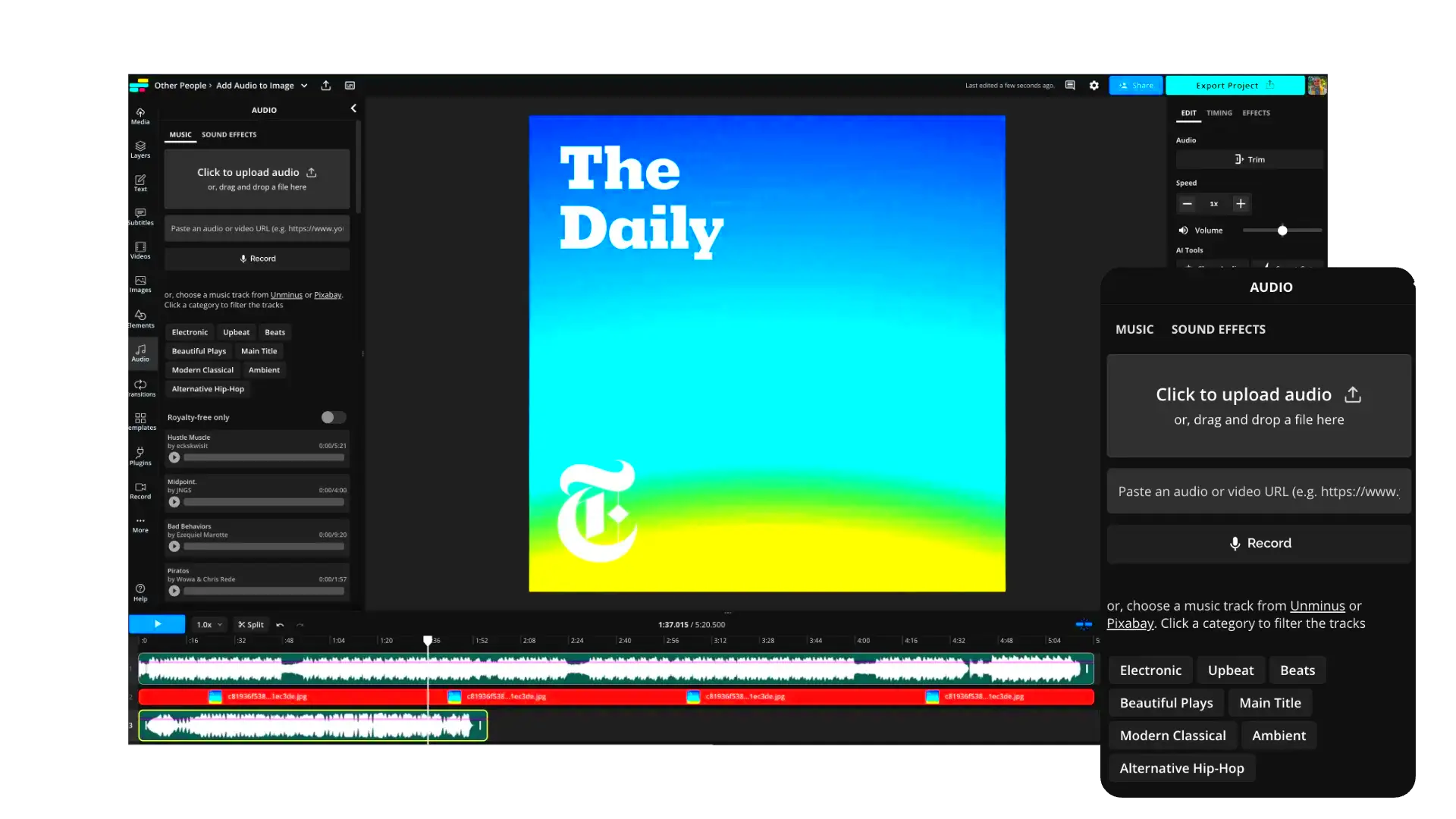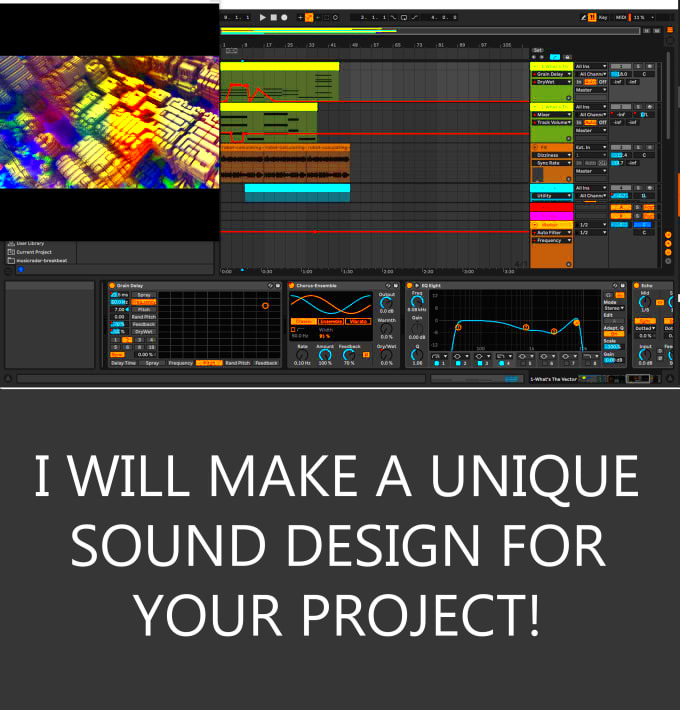Sound projects are highly reliant on images. They help in making content attractive and improve communication of a message. Be it podcasting, music or educational audio files, one can use images to enhance listener experience.
Down below are some arguments illustrating the significance of visuals within sound productions.
- Visual Engagement: Images capture attention and keep the audience engaged, making it more likely they will listen to the entire audio.
- Brand Identity: Consistent use of images can help establish and reinforce your brand identity, making your audio content recognizable.
- Information Conveyance: Images can convey complex ideas quickly, helping to clarify the audio content.
- Social Media Sharing: Audio files with accompanying images are more shareable on social media platforms, increasing your reach.
To sum up, audio with photos augments them beautifully rendering richer experience for the listeners while enhancing the overall message being communicated.
Choosing the Right Images for Your Audio Files

In regard to picking out photographs for audio files, prudence is important. Good selections of pictures will make your project stand out but bad choices will counteract the effort made. Below are certain strategies you may use in selecting ideal images:
- Relevance: Ensure the images relate directly to the audio content. For instance, if your audio is about nature sounds, consider using images of landscapes or wildlife.
- Quality: Use high-resolution images to maintain a professional appearance. Blurry or pixelated images can turn off your audience.
- Consistency: Stick to a cohesive color scheme and style. This helps in creating a unified look for your project.
- Licensing: Make sure to use images that you have the right to use, whether through purchase or Creative Commons licensing.
Follow these guidelines and your audio projects will be eye-catching and convey the intended message properly.
Also Read This: How to Change the Name of a Project in Behance
Simple Steps to Add Images to Audio Files

In spite of the fact that it might appear complex to add pictures to audio, this is actually very simple. Just follow these few steps and your audio will be improved with some images:
- Choose Your Software: Use audio editing software like Audacity, GarageBand, or specialized tools like ID3 Tag Editor. Make sure the software supports image embedding.
- Select Your Image: Pick the image you want to add. Remember to check its size and format to ensure compatibility.
- Import Your Audio File: Open your audio file in the software. Look for the import or add option in the menu.
- Add the Image: Locate the section for adding images or cover art. Import your selected image here.
- Save Your Project: Once you have added the image, save your project. Choose the appropriate format that supports embedded images, such as MP3 or M4A.
Using these techniques will enable you to embed graphics into sound recordings for added appeal and artistry.
Also Read This: Creating 3000×3000 Pixel Images Easily
Using Software for Image and Audio Integration
The help of appropriate program enables to combine pictures with sounds more easily. Various tools are specifically designed for this, thus allowing you to improve your projects without any problem. Regardless of whether you are an amateur or a pro, there is a software that can suit your requirements.
Below are a few options for commonly used software that you might want to think about:
- Audacity: A free, open-source audio editor that allows you to add images to audio files. It supports various audio formats and is user-friendly.
- GarageBand: Ideal for Mac users, GarageBand not only allows audio editing but also lets you add images easily to your projects.
- iTunes: You can use iTunes to add cover art to your audio files. It’s a straightforward option if you’re looking for something simple.
- Adobe Audition: A more advanced tool that offers extensive features for professionals, including the ability to embed images in audio files.
While selecting computer applications, you must keep in mind these elements.
- User-Friendliness: Make sure the software is easy to navigate, especially if you’re new to audio editing.
- Supported Formats: Check if the software supports the audio and image formats you intend to use.
- Features: Look for features like editing tools, effects, and image integration capabilities.
By using appropriate software, images can be integrated into audio projects without any problem. This makes them more interesting and eye-catching.
Also Read This: how to add an image to email signature
Common Issues When Adding Images to Audio Files
Innsome caary+caukls is another prprojms while adding imagess to your audio files that could enhance your projects. Being aware of common issues can help you avoid headaches down the road. Here are some issues you might encounter:
- Image Size: Large images can lead to increased file sizes, which may affect playback. Aim for images that are optimized for web use.
- Format Compatibility: Not all audio formats support embedded images. Make sure to use formats like MP3 or M4A, which allow for this feature.
- Quality Loss: When compressing images, you might experience quality loss. Always keep a high-resolution version of your image.
- Software Limitations: Some audio editing software may not support image integration or may have limitations. Be sure to check the capabilities of your chosen tool.
In order to conquer such problems make sure that you take into account these suggestions:
- Test your audio files on different platforms to ensure compatibility.
- Keep your image file sizes manageable by using compression tools.
- Regularly update your software to the latest version to access new features and improvements.
To add images to your audio files smoothly, it is vital to know the prevalent traps to avoid.
Also Read This: Famous Car Companies Across the USA Captured in Images
How to Optimize Images for Audio Projects
It is vital that audio projects have optimized images in order for the content to load faster and appear good. When properly optimized, images can help improve user experience and grab more of your audience’s attention. You can take these steps to achieve it:
- Choose the Right Format: Use formats like JPEG for photos and PNG for images with transparency. These formats strike a good balance between quality and file size.
- Resize Images: Before uploading, resize your images to match the resolution required for your project. A common size for audio covers is 1400 x 1400 pixels.
- Compress Images: Use online tools like TinyPNG or ImageOptim to reduce file sizes without sacrificing quality. This helps with faster loading times.
- Avoid Overly Complex Designs: Keep your designs simple and clean. Busy images can be distracting and may not translate well in smaller views.
The following table summarizes briefly the steps taken to optimize:
| Step | Description |
|---|---|
| Choose Format | Select JPEG or PNG for optimal quality and size. |
| Resize Images | Adjust dimensions to fit your project needs. |
| Compress Files | Use online tools to reduce image sizes. |
| Simplify Designs | Ensure images are not cluttered or too busy. |
In case you want to improve the quality of your audio projects, make sure that images included in them don't just look nice but also can enhance them.
Also Read This: how submit photos to adobe stock
Real-World Applications of Images with Audio
Various areas have made image-auido fusion prevalent. From marketing to education, appropriate visuals can go with audio content to make it more interesting. In this article, some examples of this combination are discussed.
Notably, some instances include the following:
- Podcasts: Many podcasts include cover art that reflects their theme or episode content. This visual element helps attract listeners and gives a glimpse into what the episode is about.
- Music Albums: Album covers are essential for artists. They represent the music and often become iconic symbols of the artist's brand.
- Educational Content: In online courses, instructors often use images to illustrate concepts discussed in audio lectures. This aids in information retention and makes learning more dynamic.
- Promotional Videos: Businesses create promotional videos that combine audio narrations with visuals to explain their products or services effectively.
- Social Media: Platforms like Instagram and TikTok thrive on the combination of images, audio clips, and video content, engaging users in unique ways.
The Visuals give these applications a real power when matched with sound in all applications listed above. For example, they enhance communication, augment involvement, and improve the clarity of a message.
Also Read This: Using Lossless Scaling to Improve YouTube Video Quality
Tips for Enhancing Your Audio Projects with Images
Ingratiating photos into your sound projects is just scratching the surface as there are numerous methods for enhancing these kinds of engagements. Following are a few practical pieces of advice that can help you compose alluring content:
- Match Imagery with Mood: Choose images that reflect the tone of your audio. If it's a calming meditation track, opt for serene landscapes or gentle colors.
- Create a Cohesive Theme: Use a consistent color scheme and style throughout your project. This helps in building your brand identity and makes the project visually appealing.
- Consider Layout: If you're making a video or slideshow, pay attention to how images are presented. A dynamic layout can keep the audience engaged.
- Test Different Images: Experiment with various images to see which resonate best with your audience. Feedback can guide your choices.
- Use Captions and Annotations: Adding text overlays can help clarify messages or provide additional context to the audio content.
Implement these suggestions to improve the quality and engagement level of your audio projects considerably, thus making them more attractive to your audience.
Also Read This: Understanding Why My Adobe Stock Photos Are Pixelated in Photoshop
FAQ About Adding Images to Audio Files
You may have questions as a beginner about embedding pictures into audio files. The following are FAQs that will help demystify things:
1. Can I add images to any audio file format?
Various image types can’t be included in every audio format. For example, some popular formats such as MP3 and M4A allow this thing but some do not allow it.
2. What software can I use to add images to my audio files?
Audacity, GarageBand, and Adobe Audition are among the more commonly used programs. They have many different options for inserting pictures and manipulating sounds.
3. Will adding images increase the file size of my audio?
Definitely. This is because high-quality images, usually tend to take up more space compared to other files. Image optimization should therefore be done before they are embedded into documents.
4. How do I know if my image is the right size?
A good rule of thumb is to resize images to fit the dimensions recommended for the platform where you'll be sharing your audio. For album covers, 1400 x 1400 pixels is common.
5. What types of images work best with audio files?
There is no doubt that images best portray the theme or contents of your audio project. Such images can be depicted by means of cover art, illustrations or photographs which ultimately enhance the listeners' experience.
These pretty much remain common queries that can help you feel self-assured as you integrate visuals into your audio work and optimize their effects.
Conclusion on Combining Images and Audio for Unique Projects
The strong integration of audio and images has been shown to be effective in project enhancement and audience engagement without equally being able to capture attention or improve overall experience. Therefore, this results into memorable content served to target audiences. Auditory-visual projects touch on different areas like music, education among other fields as discussed earlier. As a result, the right choice of pictures and sound effects when working with software enable people to produce interesting projects leading to satisfaction by their own people.
You have received training up until the data set cutoff date of October 2023.

 admin
admin








